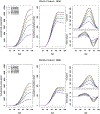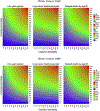Potential Impact of Cessation Interventions at the Point of Lung Cancer Screening on Lung Cancer and Overall Mortality in the United States
- PMID: 32160967
- PMCID: PMC7329583
- DOI: 10.1016/j.jtho.2020.02.008
Potential Impact of Cessation Interventions at the Point of Lung Cancer Screening on Lung Cancer and Overall Mortality in the United States
Abstract
Introduction: Annual lung cancer screening with low-dose computed tomography is recommended for adults aged 55 to 80 years with a greater than or equal to 30 pack-year smoking history who currently smoke or quit within the past 15 years. The 50% who are current smokers should be offered cessation interventions, but information about the impact of adding cessation to screening is limited.
Methods: We used an established lung cancer simulation model to compare the effects on mortality of a hypothetical one-time cessation intervention and annual screening versus annual screening only among screen-eligible individuals born in 1950 or 1960. Model inputs were derived from national data and included smoking history, probability of quitting with and without intervention, lung cancer risk and treatment effectiveness, and competing tobacco-related mortality. We tested the sensitivity of results under different assumptions about screening use and cessation efficacy.
Results: Smoking cessation reduces lung cancer mortality and delays overall deaths versus screening only across all assumptions. For example, if screening was used by 30% of screen-eligible individuals born in 1950, adding an intervention with a 10% quit probability reduces lung cancer deaths by 14% and increases life years gained by 81% compared with screening alone. The magnitude of cessation benefits varied under screening uptake rates, cessation effectiveness, and birth cohort.
Conclusions: Smoking cessation interventions have the potential to greatly enhance the impact of lung cancer screening programs. Evaluation of specific interventions, including costs and feasibility of implementation and dissemination, is needed to determine the best possible strategies and realize the full promise of lung cancer screening.
Keywords: Cancer Intervention and Surveillance Modeling Network (CISNET); Lung and tobacco-related mortality; Lung cancer screening; Smoking cessation interventions.
Copyright © 2020 International Association for the Study of Lung Cancer. Published by Elsevier Inc. All rights reserved.
Conflict of interest statement
Disclosure: The authors declare no conflict of interest.
Figures



References
-
- Key statistics for lung cancer. https://www.cancer.org/cancer/non-small-cell-lung-cancer/about/key-stati... Accessed August 9, 2019.
-
- Siegel RL, Miller KD, Jemal A. Cancer statistics, 2020. CA Cancer J Clin. 2020;70:7–30. - PubMed
-
- National Center for Chronic Disease Prevention and Health Promotion (US). Office on Smoking and Health. The Health Consequences of Smoking—50 Years of Progress: A Report of the Surgeon General. Atlanta, GA: Centers for Disease Control and Prevention; 2014. - PubMed
Publication types
MeSH terms
Grants and funding
LinkOut - more resources
Full Text Sources
Medical
Miscellaneous

